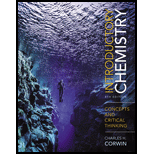
Concept explainers
(a)
Interpretation:
The freezing point of water on the given temperature scale is to be stated.
Concept introduction:
Temperature can be measured in Kelvin scale, Celsius scale and Fahrenheit scale. Celsius is the commonly used measurement unit for temperature. SI unit of temperature is Kelvin.
(b)
Interpretation:
The freezing point of water on the given temperature scale is to be stated.
Concept introduction:
Temperature can be measured in Kelvin scale, Celsius scale and Fahrenheit scale. Celsius is the commonly used measurement unit for temperature. Kelvin is the SI unit of temperature.
(c)
Interpretation:
The freezing point of water on the given temperature scale is to be stated.
Concept introduction:
Temperature can be measured in Kelvin scale, Celsius scale and Fahrenheit scale. Celsius is the commonly used measurement unit for temperature. Kelvin is the SI unit of temperature.
Want to see the full answer?
Check out a sample textbook solution
Chapter 2 Solutions
Introductory Chemistry: Concepts and Critical Thinking (8th Edition)
- Identify the following properties as either extensive or intensive.(a) volume(b) temperature(c) humidity(d) heat(e) boiling pointarrow_forwardClassify each property as physical or chemical. (a) the tendency of silver to tarnish(b) the shine of chrome(c) the color of gold(d) the flammability of propane gasarrow_forwardClassify each change as physical or chemical. (a) the explosion of gunpowder in the barrel of a gun(b) the melting of gold in a furnace(c) the bubbling that occurs when you mix baking soda andvinegar(d) the bubbling that occurs when water boilsarrow_forward
- State whether each of the following is a physical or a chemical property. (a) Sugar ferments to ethanol. (b) Ethanol dissolves in gasoline. (c) Ethylene glycol freezes at -12 °C. (d) Ethanol burns with a light blue flame.arrow_forwardState whether the following properties of matter arephysical or chemical.(a) An iron nail is attracted to a magnet.(b) A piece of paper spontaneously ignites when itstemperature reaches 451 °F.(c) A bronze statue develops a green coating (patina)over time.(d) A block of wood floats on water.arrow_forwardClassify each of the following as a physical change or a chemical change. (a) Touching a lit candle to hydrogen soap bubbles gives an explosion. (b)Heating water in a flask produces moisture on the glass. (c) Combining two colorless solutions gives a yellow solid. (d) Pouring vinegar on baking soda produces gas bubbles.arrow_forward
- State whether the following will sink or float when dropped into water. (a) wax (d = 0.90 g/cm³) (b) marble (d = 3.5 g/cm³arrow_forwardClassify the following as solution or heterogeneous mixture. (a) normal urine (b) gasoline (c) batter for chocolate chip cookiesarrow_forwardWhich of the following is an inexact quantity?(b) the mass of a pennyarrow_forward
- Define physical changeand chemical change.State which type of change occurs in each of the following statements:(a) Passing an electric current through molten magnesium chlo-ride yields molten magnesium and gaseous chlorine.(b) The iron in discarded automobiles slowly forms reddishbrown, crumbly rust.arrow_forwardClassify each of the following changes as physical or chemical: (a)condensation of steam(b) burning of gasoline(c) souring of milk(d) dissolving of sugar in water(e) melting of gold (f) coal burning(g) ice melting(h) mixing chocolate syrup with milk(h)explosion of a firecracker(j)magnetizing of a screwdriverarrow_forwardClassify each property as physical or chemical. (a) the tendency of copper to turn green when exposed to air(b) the tendency of automobile paint to dull over time(c) the tendency of gasoline to evaporate quickly when spilled(d) the low mass (for a given volume) of aluminum relative to other metalsarrow_forward
 ChemistryChemistryISBN:9781305957404Author:Steven S. Zumdahl, Susan A. Zumdahl, Donald J. DeCostePublisher:Cengage Learning
ChemistryChemistryISBN:9781305957404Author:Steven S. Zumdahl, Susan A. Zumdahl, Donald J. DeCostePublisher:Cengage Learning ChemistryChemistryISBN:9781259911156Author:Raymond Chang Dr., Jason Overby ProfessorPublisher:McGraw-Hill Education
ChemistryChemistryISBN:9781259911156Author:Raymond Chang Dr., Jason Overby ProfessorPublisher:McGraw-Hill Education Principles of Instrumental AnalysisChemistryISBN:9781305577213Author:Douglas A. Skoog, F. James Holler, Stanley R. CrouchPublisher:Cengage Learning
Principles of Instrumental AnalysisChemistryISBN:9781305577213Author:Douglas A. Skoog, F. James Holler, Stanley R. CrouchPublisher:Cengage Learning Organic ChemistryChemistryISBN:9780078021558Author:Janice Gorzynski Smith Dr.Publisher:McGraw-Hill Education
Organic ChemistryChemistryISBN:9780078021558Author:Janice Gorzynski Smith Dr.Publisher:McGraw-Hill Education Chemistry: Principles and ReactionsChemistryISBN:9781305079373Author:William L. Masterton, Cecile N. HurleyPublisher:Cengage Learning
Chemistry: Principles and ReactionsChemistryISBN:9781305079373Author:William L. Masterton, Cecile N. HurleyPublisher:Cengage Learning Elementary Principles of Chemical Processes, Bind...ChemistryISBN:9781118431221Author:Richard M. Felder, Ronald W. Rousseau, Lisa G. BullardPublisher:WILEY
Elementary Principles of Chemical Processes, Bind...ChemistryISBN:9781118431221Author:Richard M. Felder, Ronald W. Rousseau, Lisa G. BullardPublisher:WILEY





